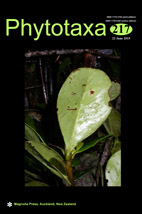Abstract
Four new species of Salvia are described and illustrated. These come from central Mexico in the region studied in the project Flora del Bajío y de Regiones Adyacentes. The four species belong to the subgenus Calosphace. Salvia carranzae is placed in the section Fulgentes and is distinguished by the stem ascending at first and then pendulous, leaves that present an irregularly dentate margin, inflorescence supine, corolla tube without papillae inside, narrow lower lip of the corolla with three very short lobules on the apex, and the upper branch of the style shorter than the lower. Salvia calderoniae has affinity with the species of section Angulatae and is distinguished by being a perennial herbaceous plant, erect, with short, lax inflorescences (3.5–10 cm) With few verticillasters 12(–19) and few flowers per verticillaster (2–8), and corolla tube arched upwards of 6–13 mm long. Salvia xolocotzii is morphologically similar to the species of section Uliginosae; it is characterized by being a herbaceous perennial plant, stoloniferous, decumbent, 15–45 cm tall, terminal inflorescence, rachis and calyx with glandular pubescence, upper lip of the calyx entire, with 5 veins, blue corolla with ventricose tube and connectives with a short acute tooth. Salvia zamoranensis coincides with the species of section Brandegeia; it is characterized by abundant long trichomes, extended on stems and calyces, calyx with 5 veins, blue corolla and ventricose, invaginated and epapillate tube, and a lower lip with two lines of white marks. The four species are distributed in forests of temperate climates and are endemic to the northeast of Guanajuato and Querétaro and southeast of San Luis Potosí.

